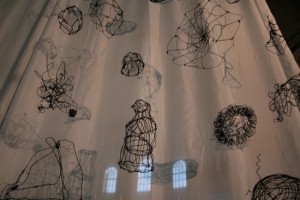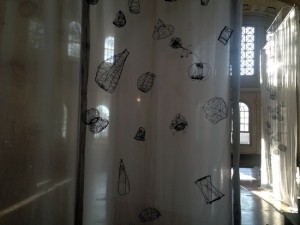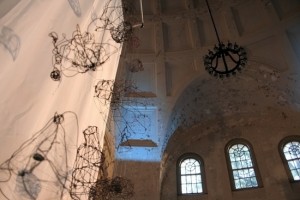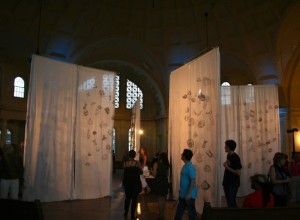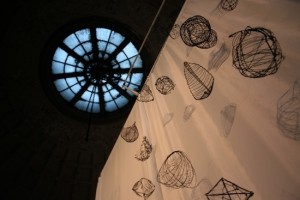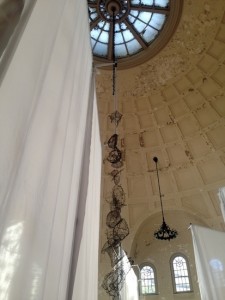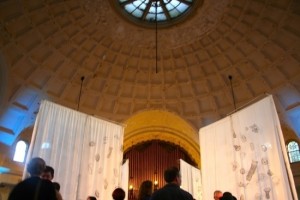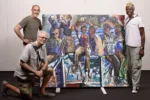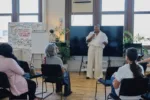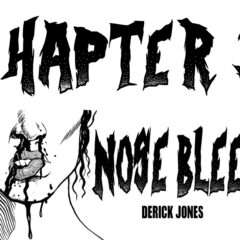—>Rachel’s post delves into a year-long anti-violence project in which artists of MamaCITA collective collaborated with Mothers in Charge to create a project to memorialize the deaths by homicide in Philadelphia in 2012. –the Artblog editors——————–>
The twisted-wire vessels — 331 of them — are suspended from metal rods, with their shadows projected onto streams of white cloth behind them that cascade to the floor. The vessels’ dark wires create linear journeys of angles, curves, hurdles and loops, manifesting into intricate casings of sculptural form. Three hundred and thirty-one documented homicides took place in Philadelphia in 2012; 331 lives were lost. Three hundred and thirty-one people became a statistic.
One Year, an installation at The Rotunda by MamaCITA artists Janice Hayes-Cha, Brenda Howell, Julie Mann, Karen Hunter McLaughlin and Kimberly Mehler, in collaboration with Philadelphia-based violence prevention organization, Mothers in Charge, confronts the violence epidemic and murder rate in Philadelphia. Each vessel represents a murder victim, individually acknowledged and then collectively remembered. In the midst of Philadelphia’s busiest month of cultural happenings, One Year may be the most important to experience.
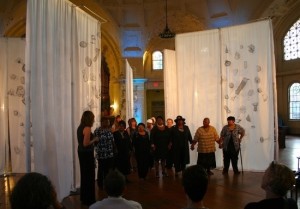
A conversation about victims of crime begins the project
One Year was born out of a conversation among the MamaCITA artists. In an interview, Janice Hayes-Cha explained the development of the concept: “We were thinking about victims of crime and began asking ourselves how to talk about that in art.” As they talked, the artists began inquiring into the number of people killed in Philadelphia in an average year. “We began talking about how we didn’t even know that number, and what if we could somehow document it. ” “And heighten the awareness of it,” Kimberly Mehler added.
The women began looking for collaborators. Julie Mann knew about Mothers in Charge and MamaCITA decided they were the people to talk to. “We were mothers and they were mothers – so we felt destined to do this project together,” Karen Hunter-McLaughlin explained. Together they decided to develop the work alongside a series of workshops that would involve members of the community in the creation of an object.
The use of wire for the commemorative objects
Drawing from Karen’s previous work with wire, the group decided upon the wire vessel as the central object. They were particularly interested in the vessel as a symbol of motherhood, and in the conceptual dualities created when light shines on the objects. Karen explained, “When the forms are lit, it creates shadows that speak to the victim and the perpetrator, the mother and the child, the body and the soul.” Indeed, these symbiotic impressions take the vessel’s abstract dimensions and bring them into concrete reality.
Also important was the material’s accessibility and inexpensiveness. Brenda Howell explained, “Karen had expertise in how to make the vessels, but we also had to choose something that all of us could create and teach.” The women were well aware that non-artists would be afraid to approach a medium such as a painting, but believed wire would be both approachable and transformative given its organic form.
The women began conducting workshops throughout 2012 that included artists and non-artists, working directly with members of Mothers in Charge, grief-support groups, and even junior-high students. While they taught, the women discussed Mothers in Charge’s work and the murder rate in Philadelphia more generally, activating a space for dialogue, healing and creativity. Kimberly explained, “Many of the participants, including Mothers in Charge, had not had many creative opportunities and felt uncreative. It was so powerful for them, because they were afraid they couldn’t do it. And they did it.”
Vessels that encapsulate a feeling
The artists invited the participants to create a feeling rather than a recognizable form. Julie Mann: “We realized early on with the community that it should be abstract rather than representational.” Consequently, each resulting vessel contains its own form, memory, and weight — unique despite the same foundational material.
During the course of the 2012 workshops, the artists monitored the Philadelphia police reports and local newspaper. Many began clipping out the few articles that made it into the press, saving remnants of names and statistics. “It really became about the numbers,” Kimberly stated. Despite the women’s focus in their own city, they were also affected by other instances of violence. “While we were making the vessels,” Janice explained, “Trayvon Martin’s murder and Sandy Hook took place. It made the work feel more timely.” The deeper the artists dove into the project, the greater their motivation and passion. And as the year progressed and the homicide rate continued to grow, the number of vessels to create climbed.
At the close of 2012, the Philadelphia police report identified three hundred and thirty-one homicides – so the women kept working until they had three hundred and thirty-one vessels. “It became about creating an awareness in volume,” Kimberly explained, “Because people don’t hold the number three hundred and thirty-one in their head. One doesn’t know how many seats that fills. You can’t see that number. We wanted to make that number visible.”
Beyond the victims was also the ripple each homicide carried out – touching the victim’s family, the perpetrator’s family, the neighborhood, and the city itself.
Performance at the opening
One Year’s first public showing was in January 2013 at The Painted Bride. In contrast to the grid-structured installation there, One Year’s current showing at The Rotunda is monumental in form. Located in The Sanctuary – a former house of worship that dates from 1911 – the work feels as though it permanently belongs. One enters the space, walking past wooden pews, and immediately feels the immense weight of the work’s intention despite the lightness of the draped cloth and suspended vessels. Situated in the center of the room beneath rusting chandeliers and flaking ceiling paint, the work invites you to move through the panels of fabric, examining each vessel and its resulting shadow up-close, while also stepping back and contemplating the collective whole.
I first experienced the work in the late afternoon, just as the sun hit the Rotunda’s giant windows and cast further shadows against the white cloth. These interacted with the shadows of the vessels and activated a dance across each panel that began moving through the space and creating new forms. As the shadows continued emerging and transforming, I could not help but consider the victims who remain undocumented and the lives soon to be lost. Then my own shadow became reflected against the cloth, myself becoming implicated in the narrative – a poignant reminder of how we are all connected to this reality and its necessary dialogue. At once quiet, firm and reflective, the installation also became active, participatory and remarkably alive.
Exhibited with the installation are mounted testimonies about individual murder victims that provide personal narratives to the otherwise anonymous numbers. During a public performance on September 7th, five mothers of homicide victims who are members of Mothers in Charge also shared poems in honor of their loved ones. The performance included call and response, drumming and a sorrowful lament led by Reverend Rhetta Morgan, Marcy Francis, and Jan Jeffries. The evening’s awe-inspiring beauty lay in its public sadness. Rather than lightening a hard and complicated topic, the women worked together to enable a space where suffering was collectively embraced and remembrance emphasized. At once graceful, beautiful and celebratory, One Year also accepts hardship, violence and grief in such a way that elegantly balances both hope and suffering.
The impact of collaboration on the project
Speaking with the artists it was clear that the greatest component of the project was their collaboration with Mothers in Charge. Each group involved one another in their organizational processes – whether that was teaching or making creative decisions. A constant dialogue and collective consensus was critical to the project and resulted in a deep sense of trust. Janice explained, “Getting to know these women that we normally wouldn’t have the opportunity to know was much more meaningful than I could have ever expected. And they are the ones who really do the work. They go into the prisons and into the schools. They are there.”
Ultimately, the women hope One Year will create further awareness about the violence in Philadelphia and encourage other artists to take on these critical questions and realities. “We would really encourage other artists to dive in and see where their art can take them in the community,” Janice said.
Indeed, the women’s example of collaboration — of working across borders, institutional methodologies and social realities — is a stunning example of the importance of conversation and consensus and of the incredible work that can be enabled through art, social trust, and public memory.
All photographs by the author
One Year was partially funded by a Leeway Foundation Art and Change Grant. Public viewings at the Rotunda took place on September 12-15 and will take place again Sept. 19-20 from 6-8pm. Another public performance is scheduled for September 21 at 6:30 pm as part of the Fringe Arts Festival. Tickets are available at http://fringearts.ticketleap.com/one-year/


